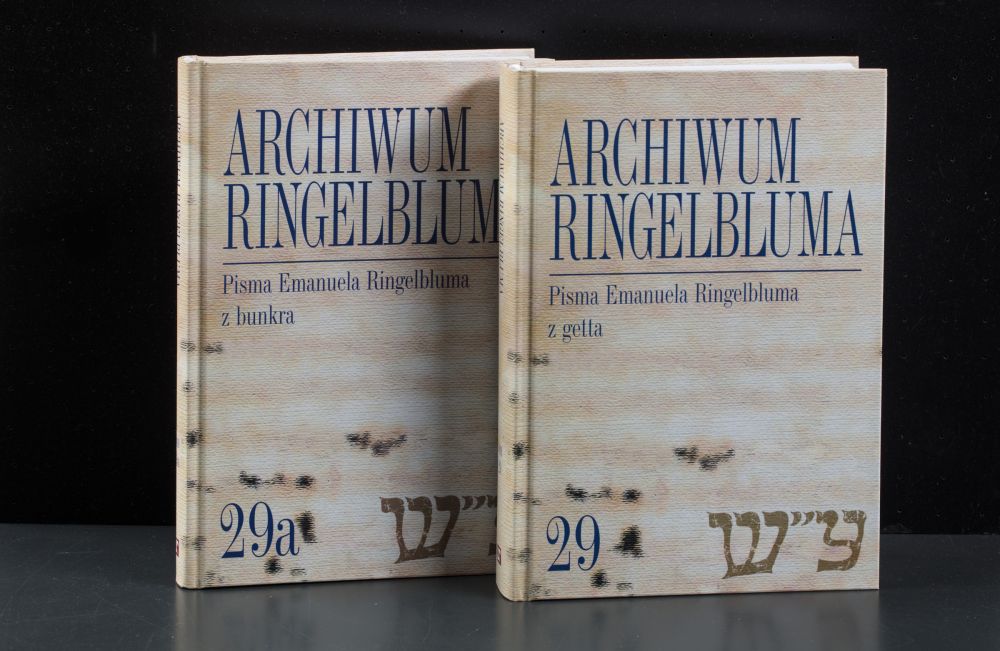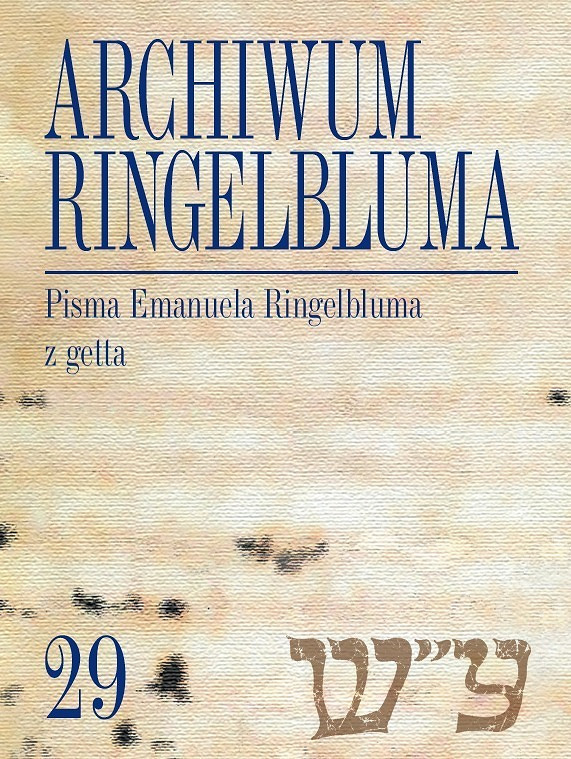- News
- Events
- Oneg Shabbat
- Collections
- Research
- Exhibitions
- Education
- Publishing Department
- Genealogy
- About the Institute
- Bookstore


The Ringelblum Archive vol. 29, Emanuel Ringelblum’s writings from the Ghetto

2018 marks the 50th anniversary of the moment when Emanuel Ringelblum’s writings were supposed to be published in Polish translation for the first time. The „March events” made it impossible, and the text remained in hiatus until 1983, when it was published as the Chronicle of the Warsaw Ghetto, translated by Adam Rutkowski and edited by Artur Eisenbach. The Chronicle didn’t cover the entirety of Ringelblum’s preserved writings – also, like all publications in the Polish People’s Republic, it was censored.
The current edition of Emanuel Ringelblum’s writings from the Ghetto contains the notes in their possibly fullest and closest to the original versions, without prior edits which changed their meaning and tone. The volume includes all known to us notes made by Ringelblum between September 1939 and January 1943. They were equipped with a new critical apparatus and placed in a context of other materials from the Archive of the Warsaw Ghetto, for which they were a starting point and inspiration. The process of developing the scientific apparatus encompassed the current state of research on the Holocaust, Ringelblum’s notes were confronted with other sources (mainly with the diaries of Abraham Lewin, Chaim Aron Kapłan, Adam Czerniaków and with Ludwik Landau’s chronicles).
There is no doubt that Ringelblum’s notes were not intended by the author to be presented to the readers in the form in which they have reached us. They served as the historian’s workshop, notebook, sometimes chaotic notes for planned future work. Ringelblum was taking his notes with various frequency, usually in Yiddish, though certain sayings, names and examples of linguistic folklore of the occupation period were written in Polish, while certain sentences – in Hebrew. Notes were written by hand on loose pieces of paper, the handwriting was difficult to decode; sometimes, they lack date. Some of them were preserved only as typewriter copies. For conspiratorial reasons, Ringelblum was also concealing his notes (especially in the early days of the occupation) as private letters, he was also using codenames for selected people.
Notes from before the Great Deportation were hidden in the first part of the Ringelblum Archive. The notes from summer of 1942 and later ones – in the second. First excerpts were published in 1948 in „Bleter far Geszichte”, a periodical published by the JHI; in the following three issues, further excerpts were published as well. In 1951, the „JHI Bulletin” published the first Polish translation of fragments from Ringelblum’s notes – about 120 pages from 1940. In 1952, they were published in print as Notes from the Warsaw Ghetto by Idisz Buch. To commemorate the 20th anniversary of the Warsaw Ghetto Uprising, the Institute published a two-volume edition of Ringelblum’s notes under a common title, Writings from the Ghetto, both published by Idisz Buch (in 1961 and 1963 respectively). In 1983, the notes were published by „Czytelnik”, in a 20,000 print run (second edition – 1988). In Israel, the complete edition of Ringelblum’s notes in the form of a book was published in 1985; between 1992–1994, the Yad Vashem Institute was publishing Writings from the Ghetto, Polish-Jewish relationships, and Ringelblum’s wartime correspondence in Hebrew translation.
Source: Joanna Nalewajko-Kulikov, Introduction to: „Pisma Emanuela Ringelbluma z getta”, ed. Joanna Nalewajko-Kulikov, JHI, Warsaw 2018.
The Ringelblum Archive vol. 29a, Emanuel Ringelblum’s writings from the bunker
In February 1943, after the second part of the Underground Archive of the Warsaw Ghetto was hidden, Emanuel Ringelblum left the ghetto in order to remain in hiding, with hopes to survive until the end of the war. Together with his wife and son, and along with more than 30 defectors, they managed to find refuge in a hiding place at 79 Grójecka street. Despite the exceptional generosity of the Wolski family – the hosts of the location, living conditions were very difficult. In spite of this, the founder of the Archive managed to write important texts there, among them an essay Polish-Jewish relationships during World War II, over eighty biographies of his colleagues and friends, as well as letters written by Ringelblum and his wife Judyta to Adolf and Basia Berman from the „Krysia” bunker. The Bermans had preserved all the documents included in this volume. The letters provide information about the Ringelblum family’s situation during their stay in the bunker, their contacts with the outside world, other people living there, the imprisonment at the labout camp in Trawniki, and conspiratorial activity.
Source: Eleonora Bergman, Tadeusz Epsztein, Introduction to: „Pisma Emanuela Ringelbluma z bunkra”, ed. Eleonora Bergman, Tadeusz Epsztein, Magdalena Siek, JHI, Warsaw 2018.
--------------------------
Published thanks to support from the Azrieli Foundation, Jewish Federations of Canada-UIA, the „March of the Living” program and the Taube Foundation.
Publishing and translating of the full edition of the Ringelblum Archive is one of the key elements of the Oneg Szabat Program. Program was implemented by the Jewish Historical Institute and the Association of the Jewish Historical Institute of Poland, within a public-private partnership.